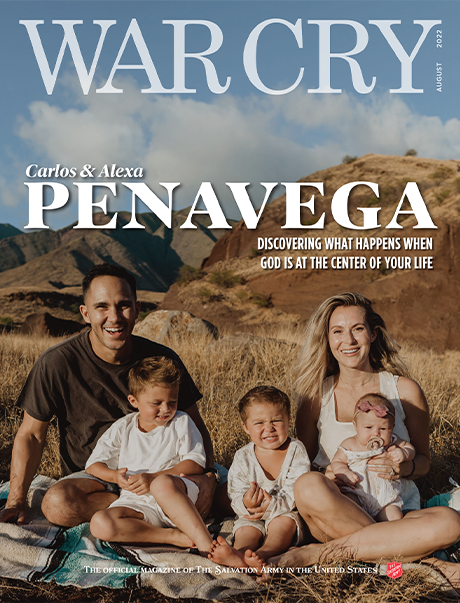Harmonies of Hope
Hearing this march served as a constant reminder of Christ’s call to repentance and His boundless ability to save from sin.
Did you know Commander Evangeline Booth asked John Philip Sousa to compose a march commemorating the 50th anniversary of The Salvation Army in the United States? She was a visionary leader who recognized the power of music to stir the soul and uplift the spirit, and who better to ask to compose for this historic and important event than The March King himself.
The new march was first played at the 50th Anniversary Golden Jubilee Congress held in New York on May 16, 1930, at the 71st Regiment Armory on Park Avenue. More than 7,000 people received it with enthusiastic applause. Sousa conducted the march and dedicated it to National Commander Evangeline Booth, daughter of the Founder, William Booth.
In introducing Sousa, Evangeline Booth noted he had “corneted and bass drummed his way into the hearts of men all over the world.” Commander Booth knew the value of music in worship as David had, writing about it so many times in the Psalms. She told the crowd of the numerous Salvation Army bands that contributed so much to the Army’s services throughout the “dark places” of the world and “fanned the spark of flame … of the never-dying love of Jesus Christ.”
Lieutenant-Commander (of the US Navy during World War I) Sousa published this work and entered into a contract on March 18, 1930 with the Theodore Presser Company of Philadelphia to publish the piano solo and band arrangement for the Army’s march. For writing the march, Presser gave Sousa 25 copies and agreed to pay him a royalty of 10 percent of the retail or marked price on the cover of all copies sold in the United States and Canada. At this time, a piece of sheet music was selling for about 60 cents.
Sousa, who had been referred to as The Pied Piper of Patriotism, knew music could uplift the human spirit, which only Sousa could do within the three minutes and 11 seconds it took to play this important march.
In recalling the premiere of this march, musical scholars were sometimes quick to point out a private comment Sousa made after conducting The Salvation Army Band that day, as evidence he was not satisfied with the piece he wrote for The Salvation Army anniversary. Sousa remarked that if he had known The Salvation Army had so many bandsmen who could play like that, he would have written a more challenging march.
The March King made that comment to bandsman Hubert E. Burtenshaw, a very capable and talented musician who had been playing bass drum for about 30 years. Sousa had a great appreciation for, and superb musical relationship with his long-time bass drummer, August Helmecke, and recognized a great bass drummer when he conducted one in a band.
Sousa, always a gracious man, was pleasantly surprised at the high level of musicianship exhibited by these Salvation Army musicians and paid them a high compliment at his own expense. But according to Colonel William H. Barrett, whom Sousa consulted concerning the approach he should take in writing the march, it was unlikely Sousa was disappointed.
At Sousa’s request, Colonel Barrett visited Sousa’s office in New York several times to provide the composer with any information he might need. Sousa asked Barrett to sing the famous Salvation Army hymn, “O Boundless Salvation,” and commented that the writer and Founder, William Booth, had been inspired to compose that piece. As one might guess, the Scripture reference for “O Boundless Salvation” is none other than John 3:16. Sousa himself was moved and inspired to meet the needs of The Salvation Army and joined Colonel Barrett as he sang the hymn for a second time. What a glorious worship session they must have had that day!
Sousa proceeded to write The Salvation Army March, perfectly appropriate for the occasion, and incorporated Booth’s hymn within its strains. It fit perfectly and was excellent for Salvation Army bands everywhere to enjoy playing; it would inspire all who heard it for generations to come. While it may not be as technically challenging or complex as some of Sousa’s marches, it was more important that it be within the musical capabilities of all who wished to play it. Sousa knew complicated or challenging did not always equate to better. The march, along with Booth’s hymn, conveyed a clear and simple message, appropriate for everyone.
Sousa captured the stirring of the soul, the simple message of salvation and the victory we have in Jesus by including Booth’s hymn in this march. Hearing this march served as a constant reminder of Christ’s call to repentance and His boundless ability to save from sin. What better way could Sousa have commemorated the first 50 years of the work of The Salvation Army in the United States?
Sousa had great affection for Salvation Army bands and their music, and visited them in New Zealand while on his world tour in August of 1911. Shortly after the Golden Jubilee Celebration in 1930, Sousa commented in the “Etude Magazine.” He said that many men had first been attracted to The Salvation Army’s message and a better life by hearing the music played by Salvation Army bands.
After conducting The Salvation Army March, Sousa was not finished.
He then conducted the massed staff and citadel bands of more than 700 musicians in “There is a Fountain Filled with Love (Blood),” as the assembled throng sang and clapped their hands in time with the music. Also on the program that day was Ensign Joseph Stanley Sheppard, an inspired and gifted 38-year-old who went by the name Red, or Stanley (never “Stan”). He and the New York Staff Band performed a cornet solo previously written and performed by former Sousa Band cornet soloist Herbert Lincoln Clark, entitled “Air Varie.”
The Jubilee program included various Salvation Army bands who played individual selections and the sound of a chorus of 1,000 voices. The program was broadcast over WNYC Radio.
This important anniversary was commemorated by a national music composition contest in which there were 104 entries. Commander Booth announced the winners, one of whom was Emil Soderstrum of the Chicago Staff Band, who had submitted “Army of God.”
Sousa’s impact on music was felt throughout the celebration. Bramwell Coles, who had earned a place in Salvation Army composition contests a little more than 20 years earlier with his march, “Ambition,” was one of the judges for this contest. Coles was considered by some to be “Salvation Army Sousa.” High praise for any musician, but a title with which the humble Coles was never comfortable. Also a judge at the event was the man who would inherit the unofficial title of “America’s Bandmaster” from Sousa, Edwin Franko Goldman.
Romans 1:20 explains people should be able to understand and recognize the eternal power, divine nature and majesty of God through His creation, which includes the art and science of music. The science is evidence of God’s creation of sound and the specific number of vibrations per second that generate what we recognize as musical notes. The art is how they are combined and arranged to form melodious and harmonious combinations of songs, hymns and marches. Sousa, as William Booth had done many years earlier, certainly took full advantage of God’s glorious creation and told the simple story of salvation through music.







